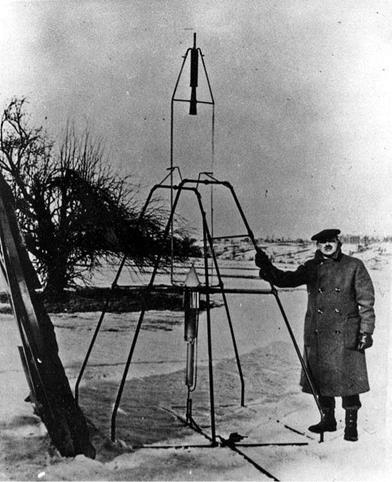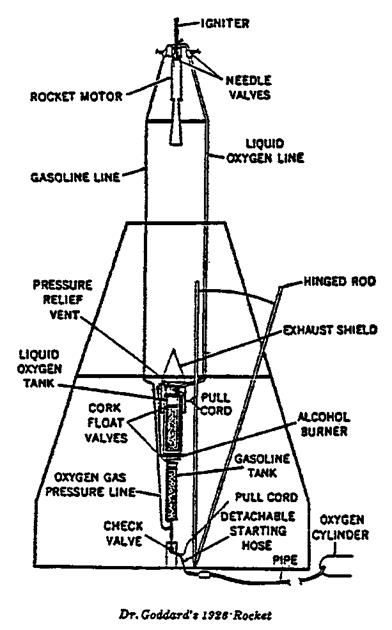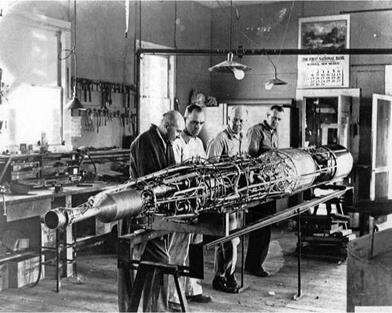The Beginnings, Goddard and Oberth, 1926-45
The history of space-launch-vehicle technology in the United States dates back to the experimenting of U. S. physicist and rocket developer Robert H. Goddard (1882-1945). A fascinating character, Goddard was supremely inventive. He is credited with 214 patents, many of them submitted after his death by his wife, Esther. These led to a settlement in 1960 by the National Aeronautics and Space Administration (NASA) and the three armed services of $1 million for use of more than 200 patents covering innovations in the fields of rocketry, guided missiles, and space exploration. In the course of his rocket research, Goddard achieved many technological breakthroughs. Among them were gyroscopic control of vanes in the exhaust of the rocket engine, film cooling of the combustion chamber, parachutes for recovery of the rocket and any instruments on it, streamlined casing, clustered engines, a gimballed tail section for stabilization, lightweight centrifugal pumps to force propellants into the combustion chamber, a gas generator, igniters, injection heads, and launch controls, although he did not use them all on any one rocket.1
Despite these impressive achievements, Goddard had less demonstrable influence on the development of subsequent missiles and space-launch vehicles than he could have had. One reason was that he epitomized the quintessential lone inventor. With excep – 8 tions, he pursued a pattern of secrecy throughout the course of his Chapter 1 career. This secretiveness hindered his country from developing missiles and rockets as rapidly as it might have done had he devoted his real abilities to the sort of cooperative development needed for the production of such complex devices.
Educated at Worcester Polytechnic Institute (B. S. in general science in 1908) and Clark University (Ph. D. in physics in 1911), Goddard seems to have begun serious work on the development of rockets February 9, 1909, when he performed his first experiment on the exhaust velocity of a rocket propellant. He continued experimentation and in 1916 applied to the Smithsonian Institution for $5,000 to launch a rocket within a short time to extreme altitudes (100-200 miles) for meteorological and other research. He received a grant for that amount in 1917. From then until 1941 he received a total of more than $200,000 for rocket research from a variety of civilian sources.2
In 1920 he published “A Method of Reaching Extreme Altitudes" in the Smithsonian Miscellaneous Collections. As Frank Winter has stated, this “publication established Goddard as the preeminent researcher in the field of rocketry" and “was unquestionably very influential in the space travel movement. . . ."3 However, important and pathbreaking as the paper was, it remained largely theoretical, calling for “necessary preliminary experiments" still to be performed.4 Following the paper’s publication, with partial hiatuses occasioned by periods of limited funding, Goddard spent the rest of the interwar period performing these experiments and trying to construct a rocket that would achieve an altitude above that reached by sounding balloons.
After experiencing frustrating problems using solid propellants, Goddard switched to liquid propellants in 1921. But it was not until March 26, 1926—nine years after his initial proposal to the Smithsonian—that he was able to achieve the world’s first known flight of a liquid-propulsion rocket at the farm of Effie Ward, a distant relative, in Auburn, Massachusetts. Goddard continued his rocket research in the desert of New Mexico after 1930 for greater isolation from human beings, who could reveal his secrets as well as be injured by his rockets. But when he finally turned from development of high-altitude rockets to wartime work in 1941, the highest altitude one of his rockets had reached (on March 26, 1937) was estimated at between 8,000 and 9,000 feet—still a long way from his stated goals.5
 One reason he had not achieved the altitudes he originally sought was that he worked with a small number of technicians instead of cooperating with other qualified rocket engineers. He achieved significant individual innovations, but he never succeeded in designing and testing all of them together in a systematic way so that the entire rocket achieved the altitudes he sought. Trained as a scientist, Goddard failed to follow standard engineering practices.6
One reason he had not achieved the altitudes he originally sought was that he worked with a small number of technicians instead of cooperating with other qualified rocket engineers. He achieved significant individual innovations, but he never succeeded in designing and testing all of them together in a systematic way so that the entire rocket achieved the altitudes he sought. Trained as a scientist, Goddard failed to follow standard engineering practices.6
More important than this shortcoming was his unwillingness to publish technical details of his rocket development and testing. At the urging of sponsors, he did publish a second paper, titled “Liquid-Propellant Rocket Development," in 1936 in the Smithsonian Miscellaneous Collections. There, Goddard addressed, much more explicitly than in his longer and more theoretical paper of 1920, the case for liquid-propellant rockets, stating their advantages over powder rockets—specifically their higher energy. Although he did discuss some details of the rockets he had developed and even included many pictures, in general the rather low level of detail and the failure to discuss many of the problems he encountered at every step of his work made this paper, like the earlier one, of limited usefulness for others trying to develop rockets.7
|
|
|

|

 In 1948, Esther Goddard and G. Edward Pen dray did publish his notes on rocket development. These contained many specifics missing from his earlier publications, but by that time the Germans under Wernher von Braun and his boss, Walter Dornberger, had developed the A-4 (V-2) missile, and a group at the Jet Propulsion Laboratory (JPL) in Pasadena, California, had also advanced well be-
In 1948, Esther Goddard and G. Edward Pen dray did publish his notes on rocket development. These contained many specifics missing from his earlier publications, but by that time the Germans under Wernher von Braun and his boss, Walter Dornberger, had developed the A-4 (V-2) missile, and a group at the Jet Propulsion Laboratory (JPL) in Pasadena, California, had also advanced well be-
|
FIG. 1.3 Robert Goddard (left) with his principal technical assistants (left to right: Nils Ljungquist, machinist; Albert Kisk, brother-in-law and machinist; and Charles Mansur, welder) in 1940 at Goddard’s shop in New Mexico. Shown is a rocket without its casing, with (right to left) the two propellant tanks and the extensive plumbing, including turbopumps to inject the propellants into the combustion chamber, where they ignite and create thrust by exhausting through the expansion nozzle (far left). (Photo courtesy of NASA) |
yond Goddard in developing rockets and missiles. He patented and developed a remarkable number of key innovations, and the two papers he did publish in his lifetime significantly influenced others to pursue rocket development. But both the Germans under von Braun and Dornberger and the U. S. effort at JPL demonstrated in varying degrees that it took a much larger effort than Goddard’s to achieve the ambitious goals he had set for himself.
Because of Goddard’s comparative secrecy, Romanian-German rocket theoretician Hermann Oberth (1894-1989), oddly, may have contributed more to U. S. launch-vehicle technology than his American counterpart. Unlike Goddard, Oberth openly published 12 the details of his more theoretical findings and contributed to their Chapter 1 popularization in Germany. Because of these efforts, he was significantly responsible for the launching of a spaceflight movement that directly influenced the V-2 missile. Then, through the immigration of Wernher von Braun and his rocket team to the United States af-
ter World War II, Oberth contributed indirectly to U. S. missile and spaceflight development.
Born almost 12 years after Goddard on June 25, 1894, in the partly Saxon German town of Hermannstadt, Transylvania, Oberth attended a number of German universities but never earned a Ph. D. because none of his professors would accept his dissertation on rocketry. Undaunted by this rejection, Oberth nevertheless “refrained from writing another" dissertation on a more acceptable and conventional topic.8
He succeeded in publishing Die Rakete zu den Planetenraumen (The Rocket into Interplanetary Space) in 1923. Although Goddard always suspected that Oberth had borrowed heavily from his 1920 paper,9 in fact Oberth’s book bears little resemblance to Goddard’s paper. Not only is Die Rakete much more filled with equations but it is also considerably longer than the paper—some 85 pages of smaller print than the 69 pages in Goddard’s paper as reprinted by the American Rocket Society in 1946. Oberth devoted much more attention than Goddard to such matters as liquid propellants and multiple – stage rockets, whereas the American dealt mostly with solid propellants and atmospheric studies but did mention the efficiency of hydrogen and oxygen as propellants. Oberth also set forth the basic principles of spaceflight to a greater extent than Goddard had done in a work much more oriented to reporting on his experimental results than to theoretical elaboration. Oberth discussed such matters as liquid-propellant rocket construction for both alcohol and hydrogen as fuels; the use of staging to escape Earth’s atmosphere; the use of pumps to inject propellants into the rocket’s combustion chamber; employment of gyroscopes for control of the rocket’s direction; chemical purification of the air in the rocket’s cabin; space walks; microgravity experiments; the ideas of a lunar orbit, space stations, reconnaissance satellites; and many other topics.10
 The book itself was influential. Besides writing it, Oberth collaborated with Max Valier, an Austrian who wrote for a popular audience, to produce less technical writings that inspired a great deal of interest in spaceflight.11 According to several sources, Oberth’s first book directly inspired Wernher von Braun (the later technical director of the German Army Ordnance facilities at Peenemunde where the V-2 was developed, subsequently director of NASA’s Marshall Space Flight Center) to study mathematics and physics, so necessary for his later work. Von Braun had already been interested in rocketry but was a poor student, especially in math and physics, in which he had gotten failing grades. However, in 1925 he had seen an ad for Oberth’s book and ordered a copy. Confronting its mathematics,
The book itself was influential. Besides writing it, Oberth collaborated with Max Valier, an Austrian who wrote for a popular audience, to produce less technical writings that inspired a great deal of interest in spaceflight.11 According to several sources, Oberth’s first book directly inspired Wernher von Braun (the later technical director of the German Army Ordnance facilities at Peenemunde where the V-2 was developed, subsequently director of NASA’s Marshall Space Flight Center) to study mathematics and physics, so necessary for his later work. Von Braun had already been interested in rocketry but was a poor student, especially in math and physics, in which he had gotten failing grades. However, in 1925 he had seen an ad for Oberth’s book and ordered a copy. Confronting its mathematics,
he took it to his secondary school math teacher, who told him the only way he could understand Oberth was to study his two worst subjects. He did and ultimately earned a Ph. D. in physics.12 Without Oberth’s stimulation, who knows whether von Braun would have become a leader in the German and U. S. rocket programs?
Similarly, von Braun’s boss at Peenemunde, Walter Dornberger, wrote to Oberth in 1964 that reading his book in 1929 had opened up a new world to him. And according to Konrad Dannenberg, who had worked at Peenemunde and come to the United States in 1945 with the rest of the von Braun team, many members of the group in Germany had become interested in space through Oberth’s books. Also in response to Oberth’s first book, in 1927 the German Society for Space Travel (Verein fur Raumschiffart) was founded to raise money for him to perform rocket experiments. He served as president in 1929-30, and the organization provided considerable practical experience in rocketry to several of its members (including von Braun). Some of them later served under von Braun at Peenemunde, although they constituted a very small fraction of the huge staff there (some 6,000 by mid-1943).13
Both Goddard and Oberth exemplified the pronouncement of Goddard at his high school graduation speech “that the dream of yesterday is the hope of today and the reality of tomorrow."14 But ironically it appears to have been Oberth who made the more important contribution to the realization of both men’s dreams.15 In any event, both men made extraordinary, pioneering contributions that were different but complementary.











